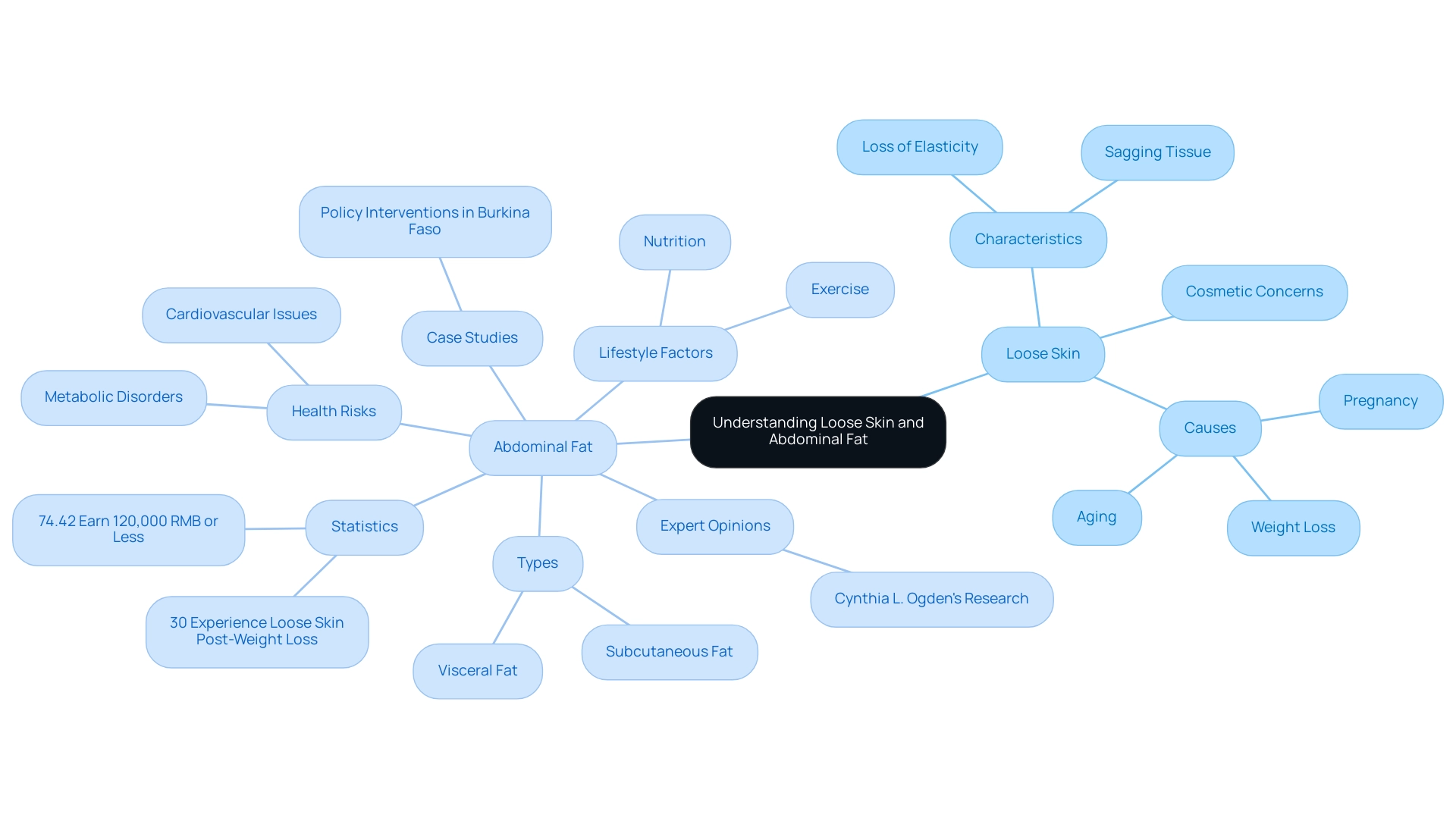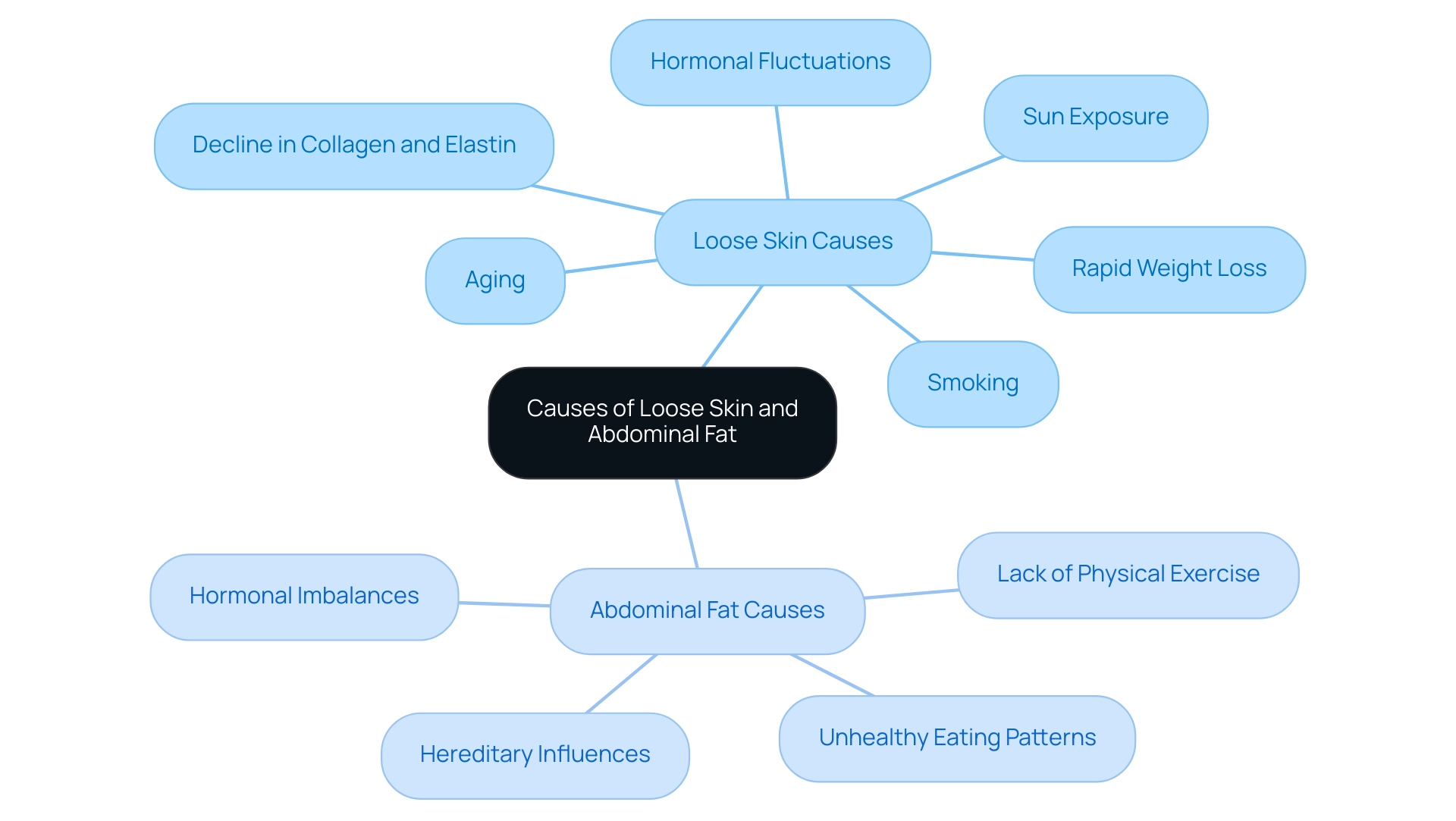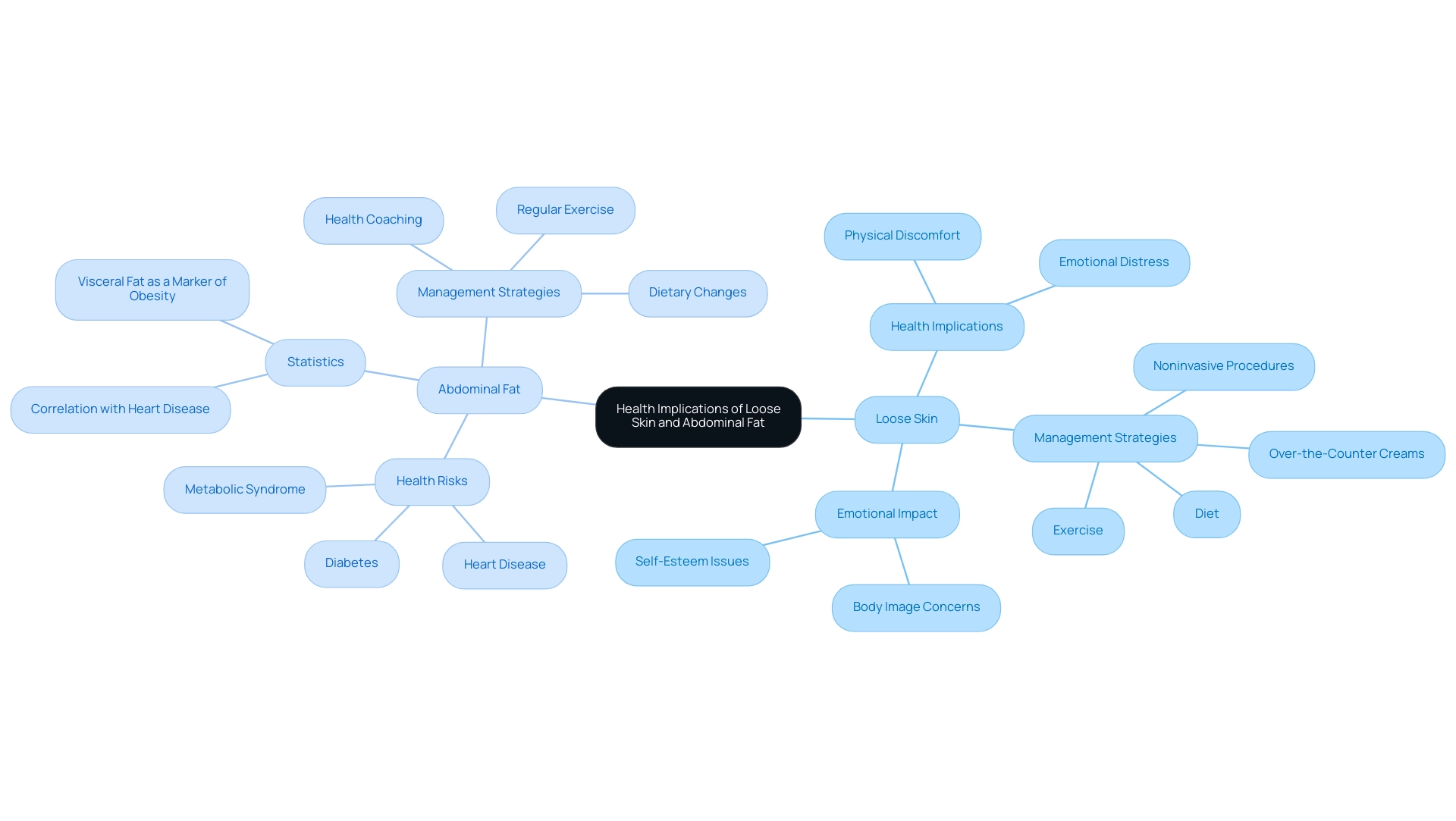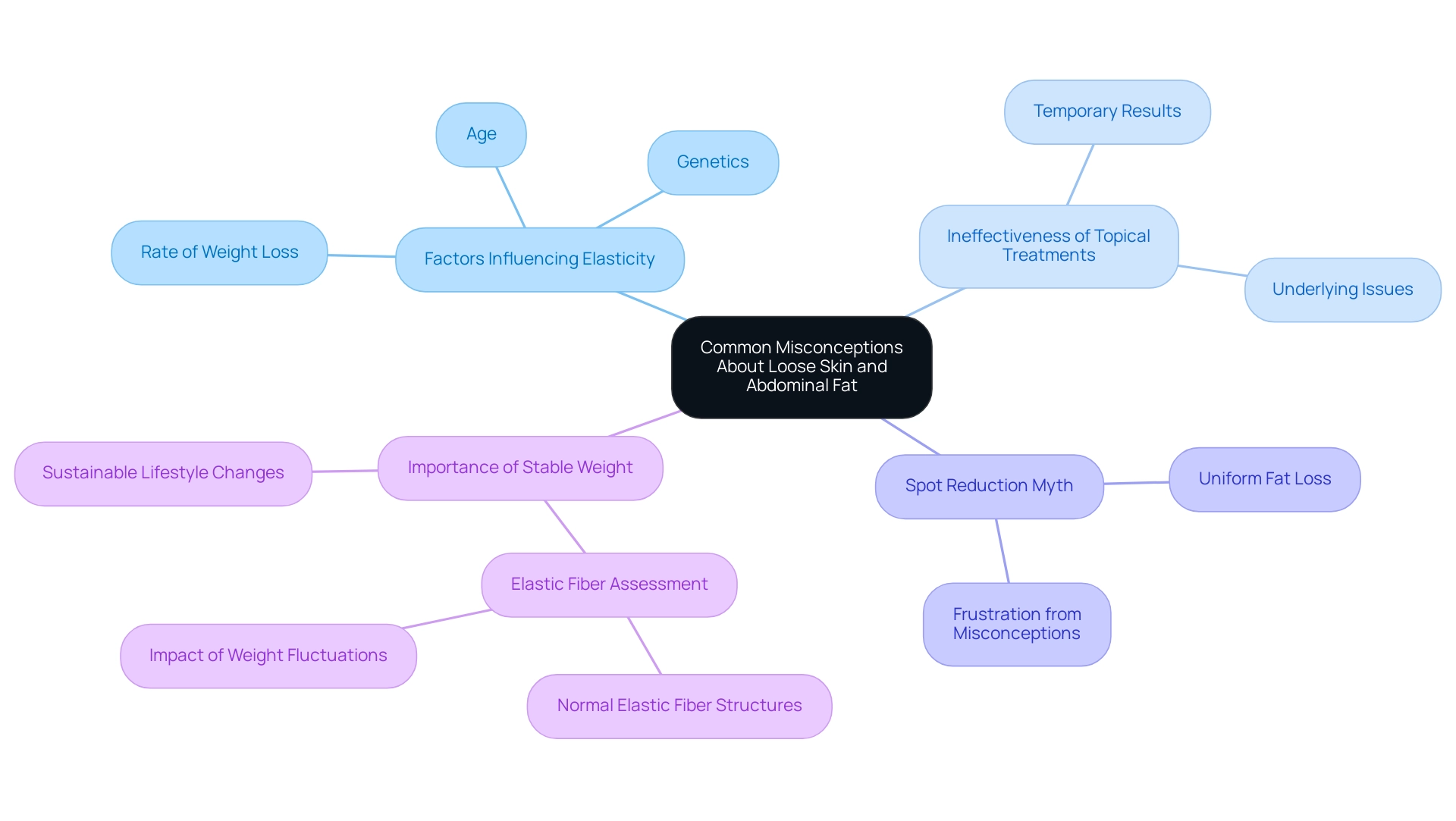Overview
Loose skin and abdominal fat differ significantly in their causes and health implications.
- Loose skin primarily results from loss of elasticity due to factors such as aging and rapid weight loss.
- In contrast, abdominal fat, particularly visceral fat, poses serious health risks, including metabolic disorders and cardiovascular diseases.
- Understanding these distinctions is crucial for individuals seeking effective management strategies.
- Loose skin can be addressed through cosmetic procedures, while abdominal fat necessitates lifestyle modifications for improved health outcomes.
Introduction
In a world where body image often takes center stage, the discussion surrounding loose skin and abdominal fat is more relevant than ever. As individuals navigate the complexities of weight loss, aging, and lifestyle choices, understanding the distinctions between these two prevalent issues becomes crucial.
Loose skin, often a cosmetic concern, can emerge after significant weight loss or due to aging, while abdominal fat poses serious health risks that extend far beyond aesthetics. With nearly 30% of adults experiencing loose skin post-weight loss and the alarming health implications tied to visceral fat, it’s essential to explore effective management strategies and treatment options.
This article delves into the causes, health implications, and lifestyle changes necessary for addressing both loose skin and abdominal fat, providing valuable insights for those seeking to enhance their overall well-being.
Understanding Loose Skin and Abdominal Fat: Definitions and Differences
Loose skin versus fat on the stomach is characterized by a loss of elasticity and firmness, often resulting from significant weight loss, aging, or pregnancy. This condition typically manifests as sagging tissue that may hang loosely from the body. In contrast, abdominal fat is categorized into two primary types: subcutaneous fat, which is located just beneath the surface, and visceral fat, which encases internal organs.
While loose tissue is primarily a cosmetic concern, abdominal fat poses serious risks to well-being, including metabolic disorders and cardiovascular conditions. Recent studies indicate that a significant percentage of adults experience loose tissue following weight loss, with estimates suggesting that nearly 30% of individuals report this condition after substantial weight reduction. Additionally, it is important to consider the economic factors influencing well-being decisions, as 74.42% of patients earn 120,000 RMB or less annually.
This underscores the significance of grasping the distinctions between loose skin and fat on the stomach, particularly for individuals striving to enhance their body image and overall well-being. Expert views stress that while loose skin versus fat on the stomach can impact self-esteem, the health dangers linked to abdominal fat are considerably more alarming. Dermatologists observe that sagging tissue is frequently a consequence of elements like genetics and the extent of loss, while abdominal fat buildup is associated with lifestyle decisions, including nutrition and exercise levels.
Furthermore, it is essential to acknowledge the limitations of studies in this area, as many utilize a cross-sectional design and self-reported questionnaires, which may affect the reliability of the findings.
Case studies have illustrated the need for targeted interventions to address the differences between loose skin and fat on the stomach. For instance, a recent initiative in Burkina Faso emphasized the importance of policy interventions to combat rising abdominal obesity, advocating for effective weight management strategies to mitigate future risks. This serves as a crucial reminder that while cosmetic issues such as loose skin versus fat on the stomach can be managed through surgical methods, the fundamental wellness implications of abdominal fat necessitate thorough lifestyle modifications.
Cynthia L. Ogden's research emphasizes the variations in estimates over time, offering authoritative insight into the changing understanding of risks linked to abdominal fat. Comprehending these distinctions between loose skin and fat on the stomach is crucial for individuals pursuing effective solutions to their body image and wellness concerns, as it enables a more informed approach to managing both. Moreover, Foresight Health Coaching's corporate partnership provides organizations with a proactive solution to tackle these wellness issues.
Through tailored wellness programs, we enhance employee health, productivity, and cognitive performance, fostering a healthier and more cohesive team culture. We invite HR Benefits Managers to contact us today to explore how our partnership can benefit your organization and support your team's well-being.

Exploring the Causes of Loose Skin and Abdominal Fat
Loose tissue primarily results from a decline in collagen and elastin—proteins essential for maintaining elasticity. This decline can be accelerated by factors such as aging, rapid loss of mass, hormonal fluctuations, sun exposure, and smoking. Research indicates that as individuals age, collagen production decreases significantly, leading to a loss of firmness and resilience in the tissue.
Moreover, quick fat loss can exacerbate this issue, as the dermis may not have adequate time to adapt to the new body form, resulting in sagging.
Conversely, the buildup of abdominal fat is frequently linked to a combination of unhealthy eating patterns, lack of physical exercise, hormonal imbalances, and hereditary influences. Nutritionists emphasize that diets high in processed foods and sugars can lead to increased visceral fat, which is particularly harmful and associated with various health issues. Consistent physical activity is essential; it not only aids in managing body mass but also enhances overall metabolic well-being.
Recent findings indicate that the relationship between aging and fat loss greatly influences dermal elasticity. A 2025 study emphasized that individuals who undergo rapid loss of mass often encounter difficulties with dermal elasticity due to a significant decrease in collagen levels. Furthermore, statistics suggest that nearly 30% of individuals who shed pounds quickly report visible loose tissue, underscoring the necessity for gradual fat loss approaches.
Additionally, case studies have demonstrated that incorporating collagen supplements can enhance tissue elasticity and diminish the visibility of sagging areas. These findings indicate that addressing both dietary habits and dermal condition is essential for individuals seeking to mitigate the impacts of aging and weight loss on their complexion. By understanding the fundamental reasons for loose skin versus fat on the stomach, individuals can make informed decisions to improve their overall well-being and appearance.
In a related study, the PCA model built on 400 differentially expressed genes revealed that PC1 represented 69% of the variation, indicating notable alterations in the dermis associated with obesity. Furthermore, Margreet Vissers noted that ongoing research is essential to fully understand the complexities of changes related to obesity. Interestingly, no significant differences were found in the average taxonomic alpha diversity of microbiota on the surface between obese and non-obese subjects, although a higher number of antimicrobial resistance genes were detected in obese individuals, highlighting potential implications for well-being.
Additionally, the protective effects of Vitamin C against UV damage illustrate the importance of antioxidants in maintaining dermal vitality and combating the effects of aging and environmental factors. These insights collectively highlight the necessity for a comprehensive approach to managing health and abdominal fat.

Health Implications of Loose Skin and Abdominal Fat
Loose tissue, often perceived merely as a cosmetic issue, can lead to significant physical discomfort, irritation, and emotional distress stemming from body image concerns. This condition typically occurs following substantial mass loss, where factors such as the rate of loss and individual genetics play crucial roles. For instance, research indicates that for every centimeter of ptosis on the thighs prior to surgery, there is a 1.31-fold increase in the odds of scoring ≥ 6 points for discomfort (OR = 1.31, p < 0.0025).
Effective management strategies for loose tissue encompass diet, exercise, over-the-counter creams, and noninvasive procedures, although their success varies based on individual circumstances, such as the extent of loss and age. Personalized coaching from Corporate Membership - Contact Our Health Coaches Today can be instrumental in this journey, providing tailored support and guidance to help individuals navigate these challenges and implement lasting lifestyle changes. A case study titled 'Loose Skin Management' underscores that loose skin following substantial weight loss can lead to physical discomfort, highlighting the necessity for effective management strategies.
Testimonials from our clients showcase the positive impact of our coaching services in addressing these concerns and achieving their wellness objectives.
Conversely, abdominal fat, particularly visceral fat, presents significant risks to well-being that must not be overlooked. This type of fat is closely associated with an increased likelihood of developing heart disease, diabetes, and metabolic syndrome. Research demonstrates that visceral fat serves not only as a marker of obesity but also as a substantial contributor to various medical complications.
For example, studies reveal that individuals with elevated levels of visceral fat face a heightened risk for cardiovascular issues, with statistics illustrating a direct correlation between visceral fat accumulation and heart disease.
The implications of abdominal fat extend beyond simple weight concerns; they encompass a spectrum of risks that can severely affect overall well-being. Therefore, addressing the issue of loose skin versus fat on the stomach is crucial for improving quality of life. By understanding these wellness implications, individuals can make informed decisions regarding their well-being strategies, ultimately leading to a more balanced and healthier lifestyle.
Furthermore, Corporate Membership - Contact Our Health Coaches Today fosters a healthier, happier, and more cohesive team culture, offering organizations the opportunity to cultivate a healthier and more resilient workforce through personalized health and wellness coaching. Contact us today to schedule a consultation and embark on your journey towards a better you!

Treatment Options: Surgical and Non-Surgical Approaches for Loose Skin and Fat
When addressing the distinction between loose skin and fat on the stomach, individuals have access to a range of treatment options. Surgical procedures, such as tummy tucks and body lifts, are designed to remove excess tissue and tighten the remaining layers, resulting in significant aesthetic improvements. These methods prove particularly effective for those who have undergone substantial weight loss, as they can restore a more contoured appearance.
Conversely, non-surgical options include tightening treatments like laser therapy and radiofrequency procedures, which stimulate collagen production and enhance skin elasticity without the need for invasive surgery.
For abdominal fat, surgical interventions like liposuction remain popular, effectively eliminating stubborn fat deposits. However, non-surgical approaches are increasingly preferred due to their minimal downtime and lower risk profiles. These methods emphasize lifestyle modifications, including diet and exercise, alongside non-invasive fat reduction techniques such as CoolSculpting. This technique differentiates between loose skin and fat by freezing fat cells, facilitating their natural elimination from the body.
Each treatment option presents distinct benefits and risks, highlighting the necessity for personalized consultations with healthcare professionals. Recent studies reveal that non-surgical treatments for addressing loose skin versus fat can achieve success rates comparable to surgical options, especially when integrated with a comprehensive wellness strategy. For example, a case study examining differential protein expression in tissue post-weight loss indicated that the method of weight loss significantly influences protein composition, a critical factor for surgical planning and patient expectations in body contouring procedures.
Understanding these protein alterations can lead to enhanced clinical treatments and surgical outcomes.
As the field progresses, the latest surgical options for treating loose tissue in 2025 feature advanced techniques that improve recovery and results. Expert opinions stress that while non-surgical tightening treatments can be effective, they often require multiple sessions to achieve desired results. Jeffrey Kenkel, M.D., asserts, "Our body contouring techniques can help patients shed that stigma, but we are quick to remind them that these procedures are major surgeries that require motivation to achieve successful outcomes."
Therefore, individuals should carefully weigh their options and seek guidance from qualified professionals to determine the most suitable course of action for their unique circumstances. Additionally, the healthcare team involved in procedures like belt lipectomy plays a crucial role in ensuring comprehensive care and optimal outcomes through effective communication and collaboration. Notably, the statistic regarding breast augmentation for men remaining static at 18 in 2018 reflects trends in surgical procedures that may influence patient decisions.

Lifestyle Changes and Preventive Strategies for Managing Loose Skin and Fat
To effectively manage the issue of loose skin versus fat on the stomach, individuals must prioritize a balanced diet rich in essential vitamins and minerals crucial for dermal health. Notably, vitamins C and E play a significant role in collagen production, which is vital for maintaining tissue elasticity. Consistent physical activity, particularly strength training, is essential as it aids in developing muscle mass, potentially enhancing the appearance of sagging areas. Engaging in strength training exercises not only improves muscle tone but also boosts metabolism, facilitating fat reduction.
Hydration is another key factor; adequate water intake supports elasticity and overall health. Avoiding smoking is equally important, as it can accelerate aging and contribute to the development of loose tissue. Moreover, adopting a gradual approach to weight loss rather than rapid loss is advisable, as this can significantly lower the risk of developing loose tissue.
Studies indicate that individuals who lose weight gradually are less likely to experience sagging compared to those who lose weight rapidly.
Alongside these lifestyle adjustments, it is crucial to consider the impact of dietary supplements on dermal well-being. There is a critical need for reliable information regarding the use and safety of these products, as highlighted by recent case studies that raise public welfare concerns about adulterated products and toxic contaminants. For instance, gamma oryzanol, derived from rice bran oil, is promoted for its antioxidant and anti-aging properties, with studies indicating its potential in preventing UV-induced cancer.
Furthermore, a bioengineered Chlorella virus has been suggested to enhance penetration against UV-induced mutations, further emphasizing the importance of safeguarding dermal well-being.
By adopting these lifestyle modifications and staying informed about the safety and effectiveness of dietary supplements, individuals can enhance their overall well-being while reducing the chances of both loose tissue and abdominal fat. Practical examples show that consistent dietary choices and exercise routines result in significant improvements in dermal condition and body composition. Expert guidance underscores the significance of a comprehensive approach, integrating nutrition, hydration, and physical activity to achieve optimal outcomes in addressing loose skin versus fat on the stomach.
As Owen Kelly notes, "The original data presented in this manuscript are openly available in USDA FoodData Central and Food," highlighting the importance of accessible information in making informed health decisions.

Common Misconceptions and FAQs About Loose Skin and Abdominal Fat
Misunderstandings regarding loose tissue are prevalent, with many believing that simply shedding pounds will lead to a firmer surface. This assumption is misleading, as the elasticity of the dermis is influenced by various factors, including age, genetics, and the rate of weight loss. Additionally, there is a widespread belief that creams and topical treatments can significantly improve laxity.
However, dermatological experts emphasize that these products typically offer only temporary results, failing to effectively address the underlying issues of elasticity.
When discussing abdominal fat, a common myth is the possibility of spot reduction—targeting fat loss in specific areas through localized exercises. In reality, fat loss occurs uniformly throughout the body, rendering it impossible to selectively reduce fat in the abdomen alone. This misconception can lead to frustration for individuals striving for a toned appearance.
Addressing these misconceptions is crucial for those seeking effective solutions regarding loose skin versus fat on the stomach. For instance, studies indicate that 85% of dieters regain the mass they lost within a year, underscoring the importance of sustainable lifestyle changes over quick fixes. As noted by Harold Edward Bays, "This Clinical Practice Statement is intended to represent the state of obesity medicine at the time of publication," highlighting the necessity for a nuanced understanding of body management.
Moreover, the nutritional composition of food consumption is a more pressing issue than the availability of plant-based foods, which is essential for comprehending dietary impacts on loss and dermal health. The effectiveness of topical treatments for laxity is often overstated, with many dermatologists observing that while these products may temporarily enhance the appearance of the surface, they do not provide lasting solutions.
Real-world examples further illustrate these points. A case study titled 'Elastic Fiber Assessment in Normal Body Mass Group' found that individuals with normal body mass exhibited predominantly normal elastic fiber structures, indicating better elasticity compared to those with significant fluctuations in mass. This emphasizes the significance of maintaining a stable weight for dermal well-being.
In summary, understanding the realities of loose skin versus fat on the stomach is essential for individuals seeking effective treatments. By debunking these myths and addressing the criticism of the 'Eat Less & Move More' mantra, individuals can make informed decisions about their health and wellness journeys.

Conclusion
Addressing the challenges of loose skin and abdominal fat is crucial for anyone navigating the journey of weight loss, aging, or lifestyle changes. Loose skin, often perceived as a cosmetic issue, can lead to emotional distress and physical discomfort, particularly following significant weight loss. Understanding its causes—such as aging, rapid weight loss, and genetic factors—empowers individuals to make informed decisions regarding treatment options, whether surgical or non-surgical. Furthermore, the health risks associated with abdominal fat, particularly visceral fat, highlight the necessity of lifestyle modifications. This type of fat is linked to serious health conditions such as heart disease and diabetes, making its management essential for overall well-being.
Incorporating a balanced diet, regular exercise, and gradual weight loss strategies can significantly enhance skin elasticity and promote fat reduction. Moreover, debunking common misconceptions about these issues is vital for achieving realistic health goals. Sustainable lifestyle changes, rather than quick fixes, are fundamental to long-term success in managing both loose skin and abdominal fat.
Ultimately, a comprehensive approach that combines education, lifestyle adjustments, and, when necessary, professional guidance can empower individuals to enhance their body image and health. By understanding the distinctions between loose skin and abdominal fat, individuals can navigate their wellness journey with confidence, leading to improved quality of life and overall health.
Frequently Asked Questions
What is the difference between loose skin and abdominal fat?
Loose skin is characterized by a loss of elasticity and firmness, often resulting from significant weight loss, aging, or pregnancy, leading to sagging tissue. In contrast, abdominal fat is categorized into subcutaneous fat, located just beneath the skin, and visceral fat, which surrounds internal organs.
What are the health implications of loose skin versus abdominal fat?
Loose skin is primarily a cosmetic concern, while abdominal fat poses serious health risks, including metabolic disorders and cardiovascular conditions.
How prevalent is loose skin after weight loss?
Research suggests that nearly 30% of individuals experience loose skin following significant weight loss.
What factors contribute to the development of loose skin?
Loose skin results from a decline in collagen and elastin due to aging, rapid weight loss, hormonal changes, sun exposure, and smoking.
What causes abdominal fat accumulation?
Abdominal fat buildup is often linked to unhealthy eating patterns, lack of physical activity, hormonal imbalances, and genetic factors.
How does aging affect skin elasticity and fat loss?
As individuals age, collagen production decreases, leading to a loss of firmness in the skin. Rapid fat loss can further exacerbate the loss of dermal elasticity.
What dietary habits can impact abdominal fat?
Diets high in processed foods and sugars can lead to increased visceral fat, which is particularly harmful to health.
What role does physical activity play in managing body fat?
Regular physical activity is essential for managing body weight and enhancing overall metabolic health.
Can collagen supplements help with loose skin?
Yes, incorporating collagen supplements may enhance tissue elasticity and reduce the visibility of sagging areas.
What is the significance of understanding the differences between loose skin and abdominal fat?
Understanding these distinctions helps individuals make informed decisions regarding their body image and wellness, leading to better management strategies for both conditions.

